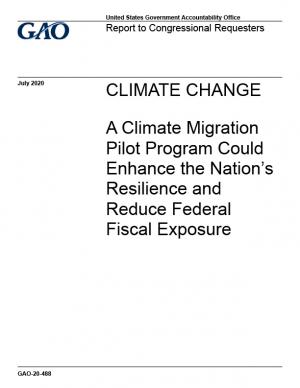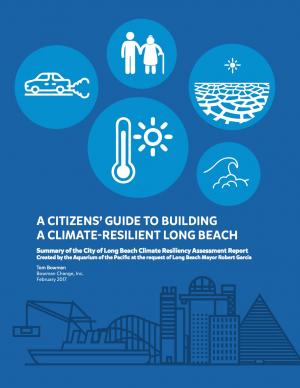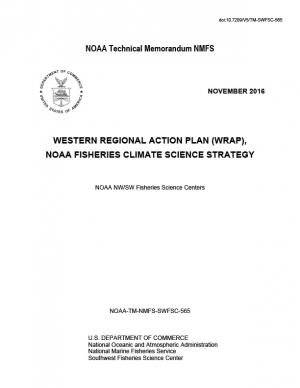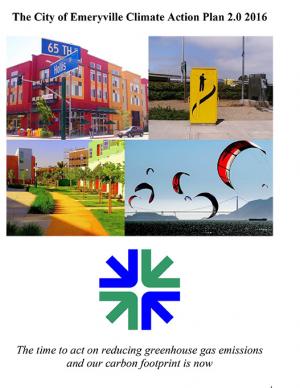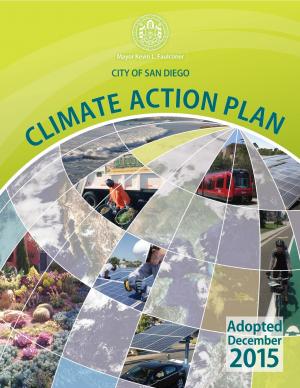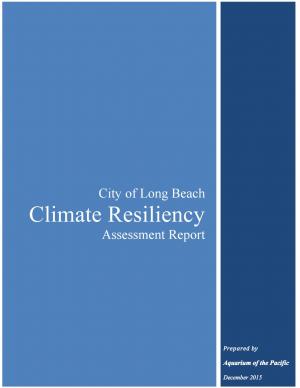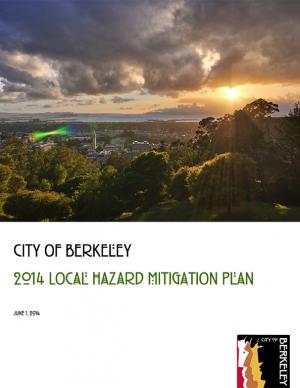Climate migration—the preemptive movement of people and property away from areas experiencing severe impacts—is one way to improve climate resilience. This report reviews federal support for climate migration, examining the use of climate migration as a resilience strategy, federal support for climate migration, key challenges to climate migration, and how the federal government can address them. A literature review and interviews with climate resilience experts was conducted, with 46 stakeholders selected and interviewed in four communities that have considered relocation: Newtok, Alaska; Santa Rosa, California; Isle de Jean Charles, Louisiana; and Smith Island, Maryland.
Access a range of climate-related reports issued by government agencies and scientific organizations. Browse the reports listed below, or filter by scope, content, or focus in the boxes above. To expand your results, click the Clear Filters link.
This user-friendly summary is based on the 2015 report “City of Long Beach Climate Resiliency Assessment Report" and “Appendices” prepared by the Aquarium of the Pacific at the request of Mayor Robert Garcia. The report includes clear infographics that describe current and projected conditions in the city. It also describe what the city is currently doing and what else the city and its residents can do.
The Western Regional Action Plan was developed to increase the production, delivery, and use of climate-related information to fulfill the NOAA Fisheries mission in the region, and identifies priority needs and specific actions to implement the NOAA Fisheries Climate Science Strategy in the West over the next three to five years. The California Current Large Marine Ecosystem (CCLME) spans the entire west coast of the continental U.S. and has significant seasonal, inter-annual, and inter-decadal fluctuations in climate that impact the marine food-web and fisheries. The CCLME is highly important economically and ecologically. Commercial and recreational fisheries in the CCLME contribute significantly to the U.S. economy, and a host of fish, bird, and mammal species depend on the productive waters and lipid-rich food web of the CCLME for their annual feeding migrations. Migrant species include several million metric tons of hake and sardine from the waters off southern California, several hundred million juvenile salmon from U.S. West Coast rivers, millions of seabirds from as far as New Zealand (sooty shearwaters) and Hawaii (Laysan and black-footed albatrosses), and tens of thousands of grey whales from Baja California and humpback whales from the Eastern North Pacific. These feeding migrations allow species to load up on energy reserves as an aid to survival during their winter months in southern extremes of their distribution. Climate-related physical processes that disrupt the CCLME ecosystem may result in negative impacts to U.S. fisheries, migrant species, and the people and communities that depend on these living marine resources.
Emeryville is the first city in California's Bay Area to update its Climate Action Plan and align its greenhouse gas (GHG) emissions targets with the State of California’s climate targets. This Climate Action Plan 2.0 includes updates to Emeryville’s 2008 Climate Action Plan, looking towards state targets for reducing 40 percent below baseline levels of GHG emissions by 2030 and 80 percent below baseline levels by 2050. The CAP 2.0 meets the compliance for the Global Covenant of Mayors, a platform for standardizing climate change action planning for local city governments and demonstrating local commitment to climate change mitigation and adaptation. The plan contains GHG targets, updated GHG community and municipal inventories, business-as-usual GHG forecast, deep decarbonization vision for 2050, adaptation and mitigation action plans, and a monitoring plan. With 17 mitigation goals, five adaptation goals, over 100 combined initiatives for 2030, and five long-term strategies for 2050, this CAP 2.0 represents a strong step in reducing emissions and building climate resilience.
With the goal of creating a cleaner San Diego for future generations, the City of San Diego’s Climate Action Plan calls for eliminating half of all greenhouse gas emissions in the City and aims for all electricity used in the city to be from renewable sources by 2035. The Climate Action Plan is a package of policies that will benefit San Diego’s environment and economy. It will help create new jobs in the renewable energy industry, improve public health and air quality, conserve water, more efficiently use existing resources, increase clean energy production, improve quality of life, and save taxpayer money. The plan identifies steps the City of San Diego can take to achieve the 2035 targets, including creating a renewable energy program, implementing a zero waste plan, and changing policy to have a majority of the City’s fleet be electric vehicles. The Climate Action Plan helps achieve the greenhouse gas reduction targets set forth by the State of California. The City’s first Climate Action Plan was approved in 2005 and a commitment to update the plan was included in the City’s 2008 General Plan update.
In January 2015, Long Beach Mayor Robert Garcia asked the Aquarium of the Pacific to take a lead in assessing the primary threats that climate change poses to Long Beach, to identify the most vulnerable neighborhoods and segments of the population, and to identify and provide a preliminary assessment of options to reduce those vulnerabilities. Over the course of 2015, the Aquarium hosted and participated in meetings and workshops with academic and government scientists, business and government leaders, local stakeholders, and Long Beach residents to discuss key issues facing our community as the result of climate change. This report, completed in December 2015, represents the culmination of these efforts. The report offers detailed assessments of the five main threats of climate change to Long Beach: drought, extreme heat, sea level rise and coastal flooding, deteriorating air quality, and public health and social vulnerability. It also provides an overview of what is currently being done to mitigate and adapt to these threats, and other options to consider. Finally, this report presents a series of steps and actions that city leaders and community stakeholders can use as a template for making Long Beach a model of a climate resilient city.
Successfully negotiating climate change challenges will require integrating a sound scientific basis for climate preparedness into local planning, resource management, infrastructure, and public health, as well as introducing new strategies to reduce greenhouse gas emissions or increase carbon sequestration into nearly every sector of California’s economy. This Research Plan presents a strategy for developing the requisite knowledge through a targeted body of policy-relevant, California-specific research over three to five years (from early 2014), and determines California’s most critical climate-related research gaps.
A five-year effort by the California Department of Water Resources, this report presents the status and trends of California's water-dependent natural resources, water supplies, and agricultural, urban, and environmental water demands for a range of plausible future scenarios. Update 2013, as it is known, is designed to work in tandem and help implement the Governor’s Water Action Plan. At more than 3,500 pages, Update 2013 covers a variety of information, from detailed descriptions of current and potential regional and statewide water conditions to a “Roadmap For Action” intended to achieve desired benefits and outcomes.
This plan—an update to the 2009 California Climate Adaptation Strategy—augments previously identified strategies in light of advances in climate science and risk management options.
This plan evaluates the risks that different hazards pose to Berkeley and engages the community in dialogue to identify the most important steps that the city and its partners should pursue to reduce these risks. The plan updates the city's plan initially adopted in 2004. To develop the 2004 Disaster Mitigation Plan, the city conducted detailed research on four major natural and two major “man-made” hazards present in Berkeley: earthquake, wildland-urban interface fire, landslide, flood, hazardous materials release, and terrorism. Since that time, new maps and data depicting the extent and possible impacts from tsunami and climate change have become available. In 2011, the city added these hazards to the list and they are incorporated into this plan..
On September 27, 2006, then-Governor Arnold Schwarzenegger signed California's Global Warming Solutions Act of 2006, which required the reduction of greenhouse gas emissions to 1990 levels by 2020. The California Air Resources Board is the lead agency for implementing the bill. One of the board's tasks was to create a scoping plan that would outline California’s strategy to achieve the 2020 greenhouse gas emission goal. This current scoping plan is an update from the original version, published in 2008. In addition to updates, this plan also contains progress reports on how California is progressing towards its goals.
This strategic plan for 2012–2017 uses a science-based approach to address climate change, sustainable fisheries and ecosystem health, land-sea interactions, and existing and emerging ocean uses. For each sector, an overarching goal is articulated along with key issues to be addressed by the California Ocean Protection Council. The plan identifies objectives for making progress toward each goal, as well as actions that the council anticipates undertaking over the plan's five-year time period.
The report introduces key health connections to climate change mitigation strategies, suggestions of where these fit into a Climate Action Plan, a process for forging partnerships between planning and health organizations, links to data that will help planners identify and reference the existing health status of their jurisdiction, and supporting resources.
A report on climate change impacts and climate change action plans for marine ecosystems on California's north-central coast. It presents scientific observations and expectations to identify potential issues related to changing climate—with an emphasis on the most likely ecological impacts and the impacts that would be most severe if they occur.

